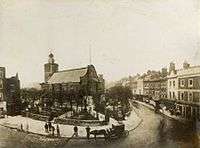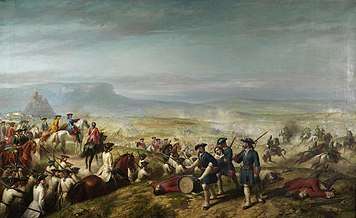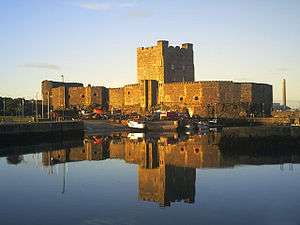Lord Mark Kerr (British Army officer)
Lord Mark Kerr (baptised 1 April 1676 – 2 February 1752) was a Scottish-born professional soldier, who served in the War of the Spanish Succession and the War of the Quadruple Alliance. He reached the rank of General in the British Army, and held a number of important administration posts, including Governor of Edinburgh Castle.
Lord Mark Kerr | |
|---|---|
| Born | 1 April 1676 (baptismal date) Newbattle, Midlothian |
| Died | 2 February 1752 Kensington, London |
| Buried | |
| Allegiance | |
| Service/ | Army |
| Years of service | 1694-1719 (Active service) |
| Rank | General |
| Unit | 29th Foot; 13th Foot; 11th Hussars |
| Commands held | Commander, Counties Down and Antrim, 1716; |
| Battles/wars | War of the Spanish Succession1702-1714 Almansa, 1707; War of the Quadruple Alliance Capture of Vigo, 1719 |
| Other work | Governor of Carrickfergus 1716 Governor of Sheerness 1729 Governor, Berwick-upon-Tweed Governor of Edinburgh Castle 1745-1752 |
Life

Lord Mark Kerr was born in 1676, fourth son of Robert Kerr, 1st Marquis of Lothian (1636-1703) and his wife, Jean Campbell (d. 1700), daughter of Archibald Campbell, 1st Marquess of Argyll. Through their relationship with Argyll, the family was closely associated with Presbyterian and Whig interests and supported the 1688 Glorious Revolution.
He never married and died in London on 2 February, 1752. He was buried in St Mary Abbots, Kensington, the memorial being lost when the church was rebuilt in 1878.
Career
In 1696, Kerr was commissioned Captain in 'McGill's Regiment of Foot;' this was disbanded in 1697 following the Treaty of Ryswick and he transferred to Lord Jedburgh's Dragoons, a regiment owned by his eldest brother.[1]
When the War of the Spanish Succession began in 1702, he joined George Macartney's Regiment of Foot, which served in Flanders; in January 1706, he became Colonel of a newly recruited unit, Lord Mark Kerr's Regiment of Foot.[2] Sent to Spain to support the Hapsburg candidate, Archduke Charles, it fought in the April, 1707 Battle of Almansa. The Anglo-Portuguese infantry were left isolated when their cavalry was routed and Kerr was wounded, while his regiment suffered severe losses.[3] With the bulk of the surviving infantry, they retreated in good order to a defensive position 8 miles/12 kilometres from the battlefield. Out of ammunition, food and water, they surrendered the next day and the opposing commander, the Duke of Berwick, illegitimate son of James II of England, invited the captured officers to dinner.[4]

Their losses at Almansa meant the regiment was reformed in 1709 and disbanded two years later, as part of the reductions passed by the Tory government installed after the 1710 British General Election. Kerr was promoted Brigadier-General, but his juniors officers placed on half-pay; several of these, including Philip Lockhart and John Nairne, later joined the 1715 Jacobite Rising.[5]
Following the death of Thomas Farrington in October 1712, Kerr became Colonel of his regiment, Farrington's, later 29th Foot; this was sent to Gibraltar, where it remained for the next 30 years. [6] Kerr may not have joined his regiment there, as in 1716 he was appointed Governor of Carrickfergus, and military commander for Counties Down and Antrim.

During the War of the Quadruple Alliance, the Spanish supported the 1719 Jacobite Rising, which was quickly crushed. In retaliation, a British naval expedition under Lord Cobham landed 6,000 troops in the Spanish port of Vigo in October; they held it for ten days, destroyed vast quantities of stores and equipment, then re-embarked unopposed.[7] Kerr commanded part of the landing force, which appears to have been his last active service command. In this period, the position of 'Colonel' implied ownership, not necessarily command and many delegated their duties to a subordinate.[8]
Kerr became Colonel of Stanhope's, later the 13th Regiment of Foot in 1725, made Major-General in 1727 and Governor of Sheerness in 1729.[9] In 1732, he transferred his Colonelcy to Philip Honywood's Dragoons, later 11th Hussars, promoted Lieutenant-General in 1735, then full General on 26 February 1743.[10]
When the 1745 Jacobite Rising began in August 1745, he was Governor, Berwick-upon-Tweed. He reportedly joked Sir John Cope, defeated at the Battle of Prestonpans in September, was the first general to bring news of his own defeat but this seems to have been a later invention by the author Sir Walter Scott.[11] Kerr was appointed Governor of Edinburgh Castle when government forces under General Handasyde retook the city on 14 November.[12] He died in London in 1752.
References
- Dalton, Charles (1896). English Army Lists and Commission Registers, 1661-1714 Volume III (2015 ed.). Sagwan Press. p. 167. ISBN 978-1297889776.
- Dalton, p.167
- "General Lord Mark Kerr". BritishEmpire.co.uk. Retrieved 7 February 2017.
- Kamen, Henry (2003). Spain's Road to Empire: The Making of a World Power, 1492-1763. Penguin. ISBN 978-0140285284. Retrieved 4 November 2018.
- Oates, Jonathan (2015). The Last Battle on English Soil, Preston 1715. Routledge. p. 120. ISBN 978-1472441553.
- Hayton, DW. "FARRINGTON, Thomas (c.1664-1712), of St. James's Street, Westminster, and Chislehurst, Kent". Parliament Online. Retrieved 9 November 2018.
- Rodger, NAM (2006). The Command of the Ocean: A Naval History of Britain 1649-1815; Volume 2. Penguin. p. 229. ISBN 9780141026909.
- Guy, Alan (1985). Economy and Discipline: Officership and the British Army, 1714–63. Manchester University Press. p. 49. ISBN 0-7190-1099-3.
- "No. 6842". The London Gazette. 23 December 1729. p. 1.
- "No. 8200". The London Gazette. 22 February 1742. p. 3.
- Cadell, Sir Robert (1898). Sir John Cope and the Rebellion of 1745. William Blackwood & Sons. p. 269.
- Riding, Jacqueline (2016). Jacobites; A New History of the 45 Rebellion. Bloomsbury. pp. 200–201. ISBN 978-1408819128.
| Military offices | ||
|---|---|---|
| Preceded by Thomas Farrington |
Colonel Lord Mark Kerr's Regiment, later 29th Foot 1712–1725 |
Succeeded by Henry Disney |
| Preceded by Unknown |
Governor of Carrickfergus 1716–? |
Succeeded by Unknown |
| Preceded by Stanhope Cotton |
Colonel Lord Mark Kerr's Regiment, later 13th Foot 1725–1732 |
Succeeded by John Middleton |
| Preceded by Henry Withers |
Governor of Sheerness 1729–1745 |
Succeeded by John Huske |
| Preceded by Sir Philip Honywood |
Colonel Lord Mark Kerr's Dragoons, later 11th Hussars 1732–1752 |
Succeeded by William Kerr, 4th Marquess of Lothian |
| Preceded by Sir James Campbell |
Governor of Edinburgh Castle 1745–1752 |
Succeeded by Humphrey Bland |